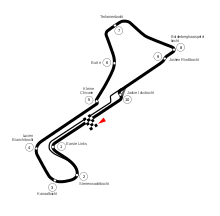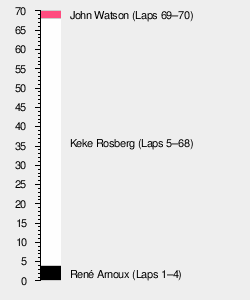1982 Belgian Grand Prix
The 1982 Belgian Grand Prix was a Formula One motor race held at Zolder on 9 May 1982. It was the fifth round of the 1982 Formula One season.
| 1982 Belgian Grand Prix | |||
|---|---|---|---|
| Race 5 of 16 in the 1982 Formula One World Championship | |||
 | |||
| Race details | |||
| Date | 9 May 1982 | ||
| Official name | XL Grote Prijs van België | ||
| Location |
Circuit Zolder Heusden-Zolder, Limburg, Belgium | ||
| Course | Permanent racing facility | ||
| Course length | 4.262 km (2.648 mi) | ||
| Distance | 70 laps, 298.340 km (185.380 mi) | ||
| Weather | Cold with air temperatures reaching up to 13 °C (55 °F)[1] | ||
| Pole position | |||
| Driver | Renault | ||
| Time | 1:15.701 | ||
| Fastest lap | |||
| Driver |
| McLaren-Ford | |
| Time | 1:20.214 on lap 67 | ||
| Podium | |||
| First | McLaren-Ford | ||
| Second | Williams-Ford | ||
| Third | Ligier-Matra | ||
|
Lap leaders
| |||
Qualifying and death of Gilles Villeneuve
Canadian driver Gilles Villeneuve was killed in an accident during the final qualifying session. At the time of the crash, his teammate Didier Pironi had set a time 0.1s faster than Villeneuve for sixth place. Contemporary and more recent writers say that he was attempting to improve his time on his final lap. Some suggest that he was specifically aiming to beat Pironi due to bitterness at being passed by him two weeks earlier in the closing stages of the San Marino Grand Prix, when Villeneuve believed Pironi had been ordered to remain behind him.[2][3] Villeneuve's biographer Gerald Donaldson quotes Ferrari race engineer Mauro Forghieri as saying that the Canadian, although pressing on in his usual fashion, was returning to the pits on his last set of qualifying tyres when the accident occurred.[4] If so, he would not have set a time on that lap.
With eight minutes of the session left, Villeneuve came over the rise after the first chicane and found Jochen Mass in the March travelling much more slowly through Butte, the left-handed bend before the Terlamenbocht corner. Mass saw Villeneuve approaching at high speed and moved to the right to let him through on the racing line. At the same instant Villeneuve also moved right to pass Mass. The Ferrari hit the back of the March and was launched into the air at a speed estimated at 200–225 km/h (120–140 mph). It was airborne for over 100 metres before nosediving into the ground and disintegrating as it somersaulted along the edge of the track. Villeneuve, still strapped to his seat but without his helmet, was thrown a further 50 metres from the wreckage into the catch fencing on the outside edge of Terlamenbocht.[4][5]
Several drivers stopped and rushed to the scene. John Watson and Derek Warwick pulled Villeneuve, his face blue, from the catch fencing.[6] The first doctor arrived on the scene within 35 seconds to find that Villeneuve was not breathing, although his pulse continued throughout; he was intubated and ventilated before being transferred to the circuit medical centre and then by helicopter to University St Raphael Hospital where a fatal fracture of the neck was diagnosed.[7] Villeneuve was kept alive on life support while his wife travelled to the hospital and the doctors consulted with specialists worldwide. He died at 9:12 that evening.[4]
The Ferrari team withdrew from the race after the accident and left the circuit. The final eight minutes of the qualifying were run after the crash debris had been removed. No drivers improved their times, leaving the Renaults of Alain Prost and René Arnoux on the front row of the grid.[8]
Abbreviated race summary
John Watson won the race after taking the lead on the penultimate lap from Keke Rosberg, who was struggling on worn tires. Niki Lauda finished third on the road but was disqualified when his car was found to be underweight in post-race scrutineering,[8] and so the final podium place went to Eddie Cheever.
Classification
Qualifying
Race
| Pos | No | Driver | Constructor | Laps | Time/Retired | Grid | Points |
|---|---|---|---|---|---|---|---|
| 1 | 7 | McLaren-Ford | 70 | 1:35:41.995 | 10 | 9 | |
| 2 | 6 | Williams-Ford | 70 | + 7.268 | 3 | 6 | |
| 3 | 25 | Ligier-Matra | 69 | + 1 Lap | 14 | 4 | |
| 4 | 11 | Lotus-Ford | 68 | + 2 Laps | 11 | 3 | |
| 5 | 1 | Brabham-BMW | 67 | + 3 Laps | 8 | 2 | |
| 6 | 20 | Fittipaldi-Ford | 67 | + 3 Laps | 23 | 1 | |
| 7 | 29 | Arrows-Ford | 66 | + 4 Laps | 22 | ||
| 8 | 18 | March-Ford | 66 | + 4 Laps | 24 | ||
| 9 | 26 | Ligier-Matra | 66 | + 4 Laps | 17 | ||
| DSQ | 8 | McLaren-Ford | 70 | Underweight | 4 | ||
| Ret | 5 | Williams-Ford | 60 | Spun Off | 13 | ||
| Ret | 17 | March-Ford | 60 | Engine | 25 | ||
| Ret | 15 | Renault | 59 | Spun Off | 1 | ||
| Ret | 2 | Brabham-BMW | 52 | Spun Off | 9 | ||
| Ret | 30 | Arrows-Ford | 51 | Throttle | 26 | ||
| Ret | 31 | Osella-Ford | 37 | Broken Wing | 16 | ||
| Ret | 22 | Alfa Romeo | 34 | Gearbox | 6 | ||
| Ret | 4 | Tyrrell-Ford | 33 | Engine | 20 | ||
| Ret | 3 | Tyrrell-Ford | 29 | Engine | 5 | ||
| Ret | 35 | Toleman-Hart | 29 | Transmission | 19 | ||
| Ret | 36 | Toleman-Hart | 13 | Brakes | 21 | ||
| Ret | 12 | Lotus-Ford | 9 | Clutch | 7 | ||
| Ret | 16 | Renault | 7 | Turbo | 2 | ||
| Ret | 9 | ATS-Ford | 0 | Clutch | 12 | ||
| Ret | 23 | Alfa Romeo | 0 | Collision | 15 | ||
| Ret | 10 | ATS-Ford | 0 | Collision | 18 | ||
| DNS | 28 | Ferrari | Withdrew due to Villeneuve's death | ||||
| DNS | 27 | Ferrari | Fatal accident during qualifying | ||||
| DNQ | 14 | Ensign-Ford | |||||
| DNQ | 33 | Theodore-Ford | |||||
| DNPQ | 32 | Osella-Ford | |||||
| DNPQ | 19 | March-Ford | |||||
Source:[10] | |||||||
Notes
- Didier Pironi and the whole Ferrari team withdrew and did not compete in the race, the second of only three times Ferrari team did not start a World Championship race in which they entered (see also 1950 French Grand Prix and 1982 Swiss Grand Prix). Pironi would be the only Ferrari driver to take part in the subsequent Monaco, Detroit (USA) and Canada rounds.
- This race marked the first and only points finish for Chico Serra, and last points to Fittipaldi.
- First podium: Eddie Cheever
Championship standings after the race
|
| ||||||||||||||||||||||||||||||||||||||||||||
- Note: Only the top five positions are included for both sets of standings.
References
- Weather info for the 1982 Belgian Grand Prix Archived 2015-02-14 at the Wayback Machine at Weather Underground
- "Formula 1's greatest drivers. Number 12: Gilles Villeneuve". BBC Sport. 4 July 2012. Retrieved 21 August 2012.
- Bamsey (1983) p.50, Lang (1992) pp.96–97, Watkins (1997) p.98 and Fearnley (May 2007) all write that Villeneuve was attempting to beat Pironi. Jenkinson (June 1982) writes only that he "was in the middle of a last desperate bid to improve his grid position."
- Donaldson (2003) pp.296–298
- Lang (1992) p.97
- Fearnley (May 2007)
- Watkins (1997) pp.96–98
- Lang (1992) pp.95 99
- "05/09/1982 race: Grand Prix of Belgium (F1) qualifying results - Racing-Reference.info". www.racing-reference.info. Retrieved 2020-04-24.
- "1982 Belgian Grand Prix". formula1.com. Archived from the original on 4 November 2014. Retrieved 23 December 2015.
- "Belgium 1982 - Championship • STATS F1". www.statsf1.com. Retrieved 12 March 2019.
Further reading
- Books
- Bamsey, Ian (1983). Automobile Sport 82-83. Yeovil, Somerset: Haynes Publications. ISBN 0-946321-01-9.
- Donaldson, Gerald (2003). Gilles Villeneuve: The Life of the Legendary Racing Driver. London: Virgin Books. ISBN 0-7535-0747-1.
- Lang, Mike (1992). Grand Prix! Volume 4: 1981 to 1984. Yeovil, Somerset: Foulis Haynes. ISBN 0-85429-733-2.
- Roebuck, Nigel (1986). Grand Prix Greats. Cambridge: Patrick Stephens Ltd. ISBN 0-85059-792-7.
- Roebuck, Nigel (1999). Chasing the Title. Yeovil, Somerset: Haynes Publications. ISBN 1-85960-604-0.
- Watkins, Sid (1997). Life at the Limit: Triumph and Tragedy in Formula One. London: Pan Books. ISBN 0-330-35139-7.
- Magazines
- Fearnley, Paul (May 2007). "It's war. Absolutely war". Motor Sport. Haymarket. pp. 52–61.
| Previous race: 1982 San Marino Grand Prix |
FIA Formula One World Championship 1982 season |
Next race: 1982 Monaco Grand Prix |
| Previous race: 1981 Belgian Grand Prix |
Belgian Grand Prix | Next race: 1983 Belgian Grand Prix |
